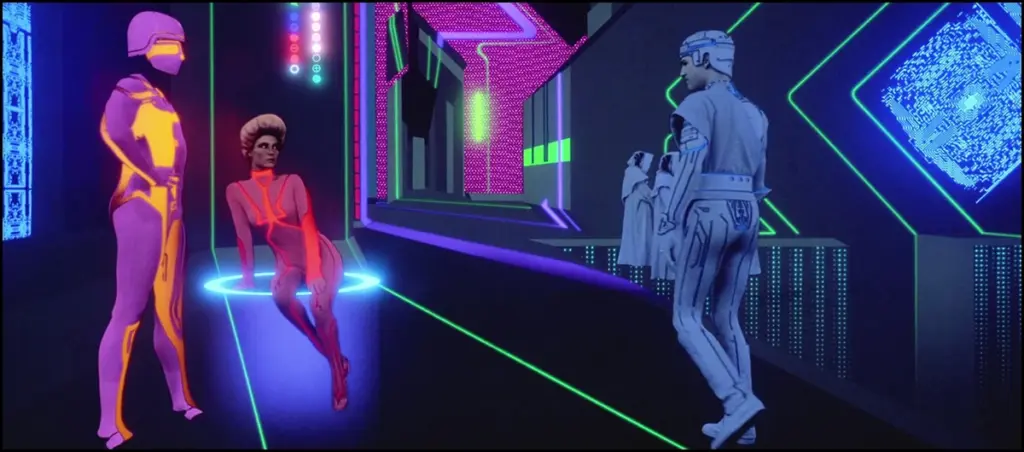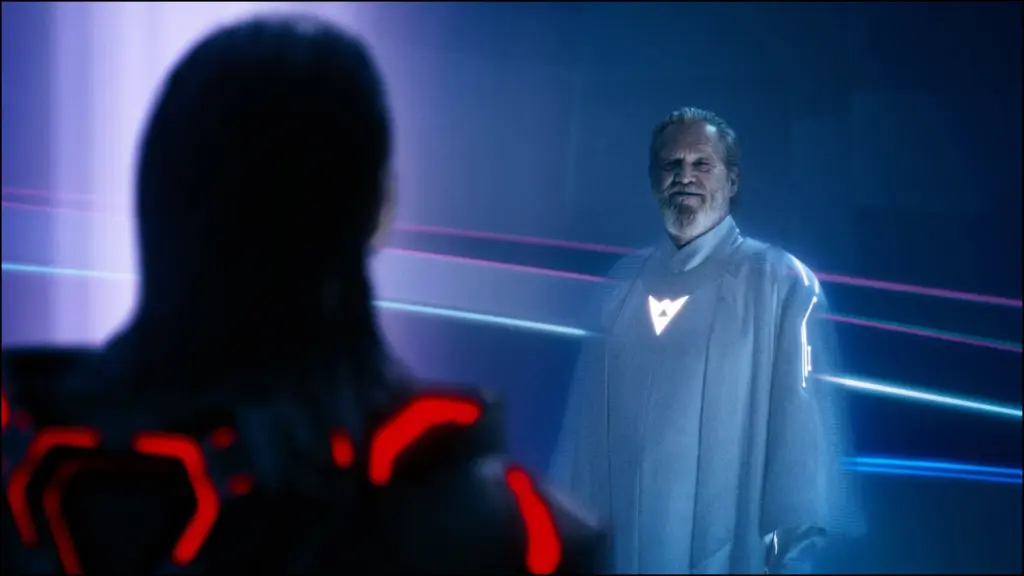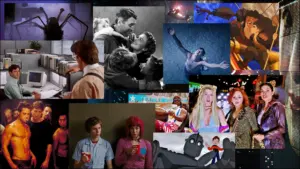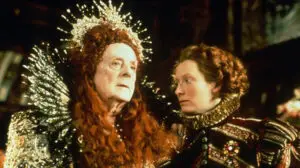In the original Tron (1982), Disney’s dystopia-in-a-computer for kids (and nostalgic adults), someone quips that in the future, “the programs will start thinking, and the people will stop.” It was a throwaway line — then. Now it hits hard. What has happened to us? Eh world?
Here’s another question: What happened to Tron? I went into TRON: Ares not asking for much. I don’t need a sensible story. I learned that the last two times. The first Tron was a palpable hallucination with a fun conceit about being zapped into CPU society. TRON: Legacy (2010), a sequel three decades later, was a buzzed dream of glossy tinted glass and pale-blue neon. Their pleasures were far more sensory than story-based. It was liking going inside the mind of a nerd to discover the subconscious of a surrealist poet.
I watched TRON: Ares, the third Tron film, asking for one thing only: Beauty. CGI beauty, tinted-laser beauty, synth-music beauty…..bring it on, Disney creatives. Make it beautiful. Alas, the makers of TRON: Ares didn’t understand the assignment. The movie feels like watching a Matrix reboot while trying to reset a digital alarm clock in the darkest corner of a laser-tag maze.

It’s a sloping progression. The first Tron would be on any top-10 list of the most visually distict films ever made. It looks like if a video game were a real place, albeit one built out of lasers, cathode rays, and the pot fumes of French animators binging vintage art-deco science fiction movies. The second Tron‘s virtual world seemed built from layers of plexiglass in a restricted palette designed to accentuate Olivia Wilde’s cheekbones.
So what makes TRON: Ares stand out? Well, it’s black and red. That’s it. Oh yeah, some of its characters (or sentient programs, if you will) carry lethal drafting triangles instead of customary round identity discs. You could easily mistake frames of TRON: Ares for those from a Terminator sequel.
I waited patiently for TRON: Ares to become beautiful, but I think director Joachim Rønning got lost trying to plow through the story, which has many moving parts and little breathing room. Even the opening scene info-dumps news reports of two competing tech companies, ENCOM and Dillinger Systems, and the contrasting personalities of their CEOs. By the time the “TRON: Ares” title appears, you feel like you just fast-forwarded through Google Slides.
The good CEO, played by Eve Kim (Greta Lee), runs ENCOM reluctantly but with decency, thanks to ethical pep talks from an AI-generated version of her deceased sister’s consciousness. The bad CEO, played by Evan Peters with a snarl and peekaboo arm tats, is a spoiled brat with no impulse control. He’s the nepo-scion grandson to the corrupt David Warner character in the first Tron, and his mom (Gillian Anderson with a bitter British accent) prods him on like Lady Macbyte.
The two companies race to master molecular 3D printing that can bring large, complex virtual machines and AI programs into material reality. The good company wants to generate stuff like orange trees, presumably to fight scurvy and mix a mean screwdriver. The bad company wants to make indestructible tanks and military equipment driven by remorseless supersoldiers who are as sexy as they are multicultural. Gotta wow the international stakeholders, after all.
One big problem: The 3D-printed stuff only lasts 29 minutes, then crumbles into what look like gray digital Legos. But Eve, with the help of tech sidekicks who have minimal, generic character traits (like Arturo Castro as an assistant who loves microwave breakfast burritos), discovers the secret to a kind of digital DNA that keeps the real-life Tron stuff from “de-rezzing.” (Side note: Must we name every woman Eve whenever she has forbidden knowledge and a treeful of fruit?)

The bad CEO finds out, sends his 29-minute supersoldiers after the good CEO, and we’re off to the races — and chases. Starting with lightcycles in midnight metropolis, emitting amber partitions to suppress or demolish adjacent vehicles. Among the supersoldiers are Ares (Jared Leto) and Athena (Jodie Turner-Smith), unsubtly named after Greek gods of war. (At least this is consistent with the previous Tron movie, which had a character named “Zuse.”)
When their sleek black-red racers chase Eve (on a white, real-world sport bike), the camera pulls back to a god’s-eye view that makes city streets resemble a digital computer grid. That’s what I wanted! A moment of beauty! Yes!
But there’s lots of movie left. Soon Eve is “rezzed” into the Matri…. I mean, virtual world, where the bad guys demand she turn over the “permanence code.” During further mayhem Ares absorbs a bit of Eve’s empathy — and starts thinking outside of the vector-based cube. Going rogue from his programming, he decides he doesn’t want to kill, he wants to love, man. And be free. As a character jokes, he’s going full Pinnochio.
TRON: Ares becomes a tale of sentient AI choosing morality over obedience, reflective emotion over cold expedience. Too bad its themes aren’t developed beyond catchphrase level. In this era of ICE agents hiding their faces like cowards and abducting people without due process, the problem with “just following orders” merits dramatic exploration. But TRON: Ares is so busy jumping through laser-red plot hoops, it fumbles its parable.
As Athena, the beautiful Jodie Turner-Smith, with close-cropped blond hair and low eyeliner like two ASCII underscore symbols, almost deepens the story. Athena shows hints of self-doubt when carrying out ruthless directives; it’s a shame the character is so underwritten. It also hits a sour note to have a dark-skinned actress casually echo Malcolm X’s “by any means necessary” line.
Of course, TRON: Ares is Jared Leto’s show, and I tried not let that bother me. I put no stock in the anti-Leto bandwagonning in Internet forums, and the less I know about his (or anyone else’s) personal lives the better. It was neither Morbin’ time nor mockin’ time; it was Tron time, dammit. Nonetheless I felt like the space-time-Leto continuum sucked a lot of electrons out of the movie’s circuitry.
In TRON: Ares, Jared Leto resembles Leslie Bibb cosplaying as Emilio Estevez in a Scientology-produced play about a shower-damp Jesus Christ selling timeshares. Leto is a skillful chameleon (you could barely recognize him in House of Gucci), and here uses a steady, composed voice to reassuring effect. But the ongoing closeups of his GQ facial hair and everything-but-the-manbun tresses framing his slightly-too-close owl eyes become visually unsettling.

Eventually Ares goes into the 1982 Tron‘s world for a Luke-meets-Yoda scene with the sagely Jeff Bridges. As much as I enjoy any visit with The Dude, the scene highlights how bleh Leto is compared to the actor who, as lead character Kevin Flynn, infused the original movie with campy charisma. Whether merrily interacting with a ball of yes-and-no digitality called Bit, clumsily steering a monstrous flying horseshoe called a Recognizer, or stealing a forbidden kiss from Yori (Cindy Morgan) before throwing a disc-golf ace in the MCP’s face, Jeff Bridges really tied the scenes together.
Late in TRON: Ares, Jared Leto seems like he’s channeling the offbeat, fish-out-of-water performance Bridges gave in Starman (1984), the John Carpenter sci-fi romance about an alien learning to be human. The scene when Leto speeds off in a “classic” Honda Civic SI resembles Starman‘s “green means go…yellow means go very fast” moment.
Strangely, as part of Ares’s growth from program to human, he learns to love Depeche Mode. I kid you not: Jared Leto the Personal Jesus explicates why he prefers the technopop “Master and Servant” band to Mozart. Are we sure Ares is fully sentient?
Speaking of music, the Nine Inch Nails soundtrack left me disappointed, especially considering the Tron franchise’s history of outstanding electronica — first by melodic Wendy Carlos (1982), later by bombastic Daft Punk (2010). NIN’s Trent Reznor and Atticus Ross have enhanced many films, including standouts like The Social Network, The Girl With the Dragon Tattoo, and Gone Girl. Here they seem to be attempting a primitive, retro-synthwave approach along the lines of Jeremy Schmidt’s score for Beyond the Black Rainbow (2014), Oneohtrix Point Never’s for Uncut Gems (2019), or the pared-down synth scores of the aforementioned John Carpenter. In TRON: Ares, NIN’s uninspired music cues don’t fit organically with the flow of the storytelling, and the loud mix overbears scenes that would have benefited from a light sonic touch. It felt like if I left the theater, I’d look up and see a colossus Trent Reznor plunking six-ton fingers on a zeppelin-sized keyboard.
Given the Reznor/Ross music, Jared Leto’s background as an effective cast member in Fight Club and Panic Room, and movie’s often ink-black aesthetic, it feels like the producers of TRON: Ares tried to channel director David Fincher. Maybe they wanted to offset the Michael Bay-ness of the climax, which has multiple flying Tron vehicles attacking the “real world” downtown of fictional Center City. All I wanted was a little beauty, but TRON: Ares ends up as lumbering as its final-boss Recognizer smashing into skyscrapers.








